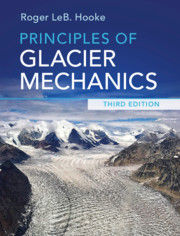Book contents
- Principles of Glacier Mechanics
- Reviews
- Principles of Glacier Mechanics
- Copyright page
- Dedication
- Contents
- Preface to the third edition
- Preface to the second edition
- Preface to the first edition
- Physical constants relevant to ice
- Derived SI units and conversion factors
- 1 Why study glaciers?
- 2 Some basic concepts
- 3 Mass balance
- 4 Flow and fracture of a crystalline material
- 5 The velocity field in a glacier
- 6 Temperature distribution in polar ice sheets
- 7 The coupling between a glacier and its bed
- 8 Water flow in and under glaciers: Geomorphic implications
- 9 Stress and deformation
- 10 Stress and velocity distribution in an idealized glacier
- 11 Numerical modeling
- 12 Applications of stress and deformation principles to classical problems
- 13 Ice streams and ice shelves
- 14 Finite strain and the origin of foliation
- 15 Response of glaciers to climate change
- 16 Ice core studies
- Problems
- References
- Index
11 - Numerical modeling
Published online by Cambridge University Press: 20 December 2019
- Principles of Glacier Mechanics
- Reviews
- Principles of Glacier Mechanics
- Copyright page
- Dedication
- Contents
- Preface to the third edition
- Preface to the second edition
- Preface to the first edition
- Physical constants relevant to ice
- Derived SI units and conversion factors
- 1 Why study glaciers?
- 2 Some basic concepts
- 3 Mass balance
- 4 Flow and fracture of a crystalline material
- 5 The velocity field in a glacier
- 6 Temperature distribution in polar ice sheets
- 7 The coupling between a glacier and its bed
- 8 Water flow in and under glaciers: Geomorphic implications
- 9 Stress and deformation
- 10 Stress and velocity distribution in an idealized glacier
- 11 Numerical modeling
- 12 Applications of stress and deformation principles to classical problems
- 13 Ice streams and ice shelves
- 14 Finite strain and the origin of foliation
- 15 Response of glaciers to climate change
- 16 Ice core studies
- Problems
- References
- Index
Summary
Numerical modeling is a way of solving complex sets of equations that cannot be solved analytically.In finite difference modeling the infinitesimal step (e.g. dx) in the governing differential equation is replaced by a finite step (e.g. "∆x" ), and the variation over this step is assumed to be linear. Integration starts at a boundary and continues stepwise across the domain. In finite element and finite volume models, the domain is discretized into elements of unequal size and equations are written relating parameters on the boundaries of these elements. This results in a system of equations that must be solved simultaneously.Because the deformation rate in a glacier is a function of temperature, and conversely, full solutions require coupling of energy balance and momentum balance equations.Examples are given involving the role of subglacial permafrost in ice sheet behavior, estimation of prior ice sheet behavior from characteristics measured in ice cores and boreholes, and use of non-deterministic models to estimate sea level rise.
Keywords
- Type
- Chapter
- Information
- Principles of Glacier Mechanics , pp. 291 - 319Publisher: Cambridge University PressPrint publication year: 2019

